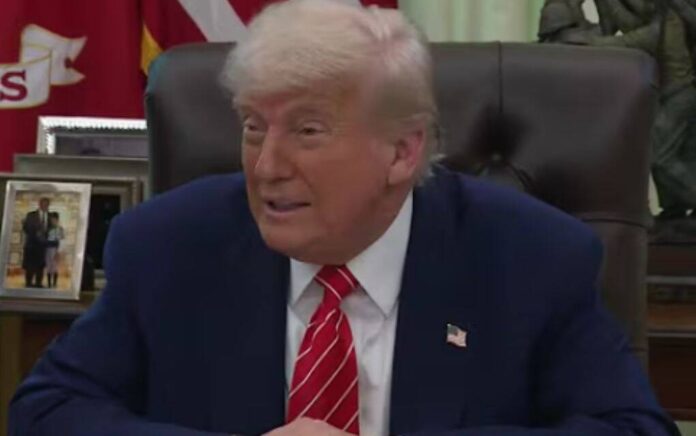
The second Trump administration has only just gotten underway. Already it faces existential threats.
Because the President was just briefed on a major problem brewing that could mean his term ends early.
GOP Must Rally Trump Voters to Secure Congress in 2026, Risk Trump’s Entire Term Otherwise
The 2026 midterm elections loom large for the Republican Party, and the stakes couldn’t be higher. If Republicans hope to keep President Donald Trump’s agenda on track, they must hold both the House and Senate. Losing either chamber could turn Trump into a lame-duck president, stymied by a Democratic Congress eager to block his every move. The key to victory lies in motivating unenthusiastic Trump voters to show up at the polls.
Recent research from J.L. Partners, first reported by Politico, reveals a troubling trend for the GOP. Many Americans who backed Trump in 2024 are feeling apathetic about voting Republican in 2026. These low-propensity voters, critical to maintaining GOP control, are disinterested in candidates who don’t carry Trump’s name or his outsider energy. Without their turnout, Republicans risk losing their slim majorities.
“Republicans will have a hard time surviving the 2026 midterms without figuring out how to engage the low-propensity Trump voter,” Sam Kay, a pollster at OnMessage Inc., told the Daily Caller News Foundation. “We’ve seen that these voters are largely apathetic toward politicians who aren’t Donald Trump. They believe he’s the only one willing to take on the Washington establishment, so they’re only interested in showing up for him.”
The solution, Kay argues, is to frame the midterms as a referendum on Trump’s agenda. “If we want low-propensity Trump voters to turn out in 2026, we need to make this election about protecting President Trump’s agenda,” Kay said. “Emphasize that the Democrats will do anything to stop him, and drive home the message that he can’t finish the job he started unless Republicans keep both the House and Senate.”
The GOP’s challenge is compounded by the unique makeup of these unmotivated voters. James Johnson, co-founder of J.L. Partners, told Politico that these voters skew younger, aged 18–29, and are more likely to be Black. “Most (64%) would still vote GOP if the election were held tomorrow, but lack a clear reason to do so,” Johnson said. Their motivation isn’t tied to judicial appointments or policy details but to a bigger vision: ensuring Republican success in the 2028 presidential election.
“They are thinking through a presidential election prism,” Johnson added. “What motivates these voters is not arguments about Trump, judicial appointments or even the 2027-9 agenda. It is instead the argument that by voting for a Republican-controlled Congress in 2026, they will help the Republicans win the presidency in 2028.” This forward-looking strategy could be the GOP’s secret weapon.
When you hear Republican members of Congress say “we can’t codify the DOGE cuts until after we win the 2026 midterm elections,” what’s your reaction? https://t.co/W3RCsPoiAL
— Mike Lee (@BasedMikeLee) May 27, 2025
Trump’s dominance in 2024, sweeping all seven swing states and shifting counties nationwide to the right, shows the power of his coalition. But midterms are a different beast. Historically, they draw lower turnout, and the GOP’s expanded base of working-class voters, while larger, isn’t as reliable in off-year elections. Meanwhile, Democrats have gained ground with white college-educated voters, who tend to show up consistently.
Kyle Kondik, managing editor of Sabato’s Crystal Ball, emphasized this challenge. “Pairing the midterm history with the demographic changes in the electorate presents a challenge for Republicans in the context of elections this year and next year, so of course Republicans will want to motivate their electorate as best that they can next year. That’s easier said than done,” Kondik told the DCNF.
Kondik also cautioned against conflating midterms with presidential races. “Midterms should be considered separately from presidential elections,” he said. “The president is not on the midterm ballot and the presidential contest has larger turnout, and midterms don’t necessarily predict presidential outcomes. Democrats, for instance, got blown out in the 2010 midterm, but that didn’t prevent Obama from winning reelection in 2012.”
The GOP’s current eight-seat House majority, thinned by recent Democratic vacancies, is precarious. The Democratic Congressional Campaign Committee (DCCC) has its sights on 35 Republican-held seats, including some in districts Trump won handily in 2024. Meanwhile, the National Republican Congressional Committee (NRCC) is targeting 26 Democratic seats to expand their edge. Every vote will count in this high-stakes battle.
In the Senate, Democrats are plotting a comeback, though some party members doubt their chances of flipping the chamber in 2026. Republicans must defend their majority fiercely, as a Democratic Senate could halt Trump’s legislative priorities in their tracks. From tax cuts to border security, the GOP needs both chambers to deliver on Trump’s promises.
Public sentiment offers some hope. An Economist/YouGov poll from May 2025 showed 41% of Americans view Republicans favorably, compared to just 36% for Democrats. This edge could fuel GOP momentum, but only if they translate it into votes. Low-propensity Trump voters, skeptical of the establishment, need a clear reason to show up.
“In the Trump era, there also has been a demographic tradeoff occurring, in which Democrats have picked up a smaller number of white college-educated voters from the Republicans while Republicans have picked up a larger number of white and nonwhite working class voters from the Democrats,” Kondik noted. This makes the GOP’s base bigger but less predictable in midterms.
“That has made the Republican coalition larger than it was before Trump, but the voters that Republicans have lost — specifically white college-educated voters — are generally more reliable voters in off-years, which may give Democrats a bit of an edge in lower-turnout elections,” Kondik added. The GOP must counter this by rallying Trump’s loyalists.
To succeed, Republicans need a relentless focus on Trump’s vision. His supporters aren’t just voting for a party—they’re voting for a movement. The GOP must channel that energy, reminding voters that a Republican Congress is the only way to protect Trump’s legacy from Democratic obstruction.



















